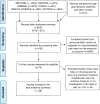Is adiposity associated with back and lower limb pain? A systematic review
- PMID: 34520462
- PMCID: PMC8439494
- DOI: 10.1371/journal.pone.0256720
Is adiposity associated with back and lower limb pain? A systematic review
Abstract
Background: Back and lower limb pain have a major impact on physical function and quality of life. While obesity is a modifiable risk factor for musculoskeletal pain, the role of adiposity is less clear. This systematic review aimed to examine the relationship between both adiposity and its distribution and back and lower limb pain.
Methods: A systematic search of electronic databases was conducted to identify studies that examined the association between anthropometric and/or direct measures of adiposity and site specific musculoskeletal pain. Risk of bias was assessed and a best evidence synthesis was performed.
Results: A total of 56 studies were identified which examined 4 pain regions, including the lower back (36 studies), hip (two studies), knee (13 studies) and foot (eight studies). 31(55%) studies were assessed as having low to moderate risk of bias. 17(30%) studies were cohort in design. The best evidence synthesis provided evidence of a relationship between central adiposity and low back and knee pain, but not hip or foot pain. There was also evidence of a longitudinal relationship between adiposity and the presence of back, knee and foot pain, as well as incident and increasing foot pain.
Conclusions: This systematic review provides evidence of an association between both body fat and its central distribution and low back and knee pain, and a longitudinal relationship between adiposity and back, knee and foot pain. These results highlight the potential for targeting adiposity in the development of novel treatments at these sites.
Conflict of interest statement
The authors have declared that no competing interests exist.
References
-
- GBD 2016 Disease and Injury Incidence and Prevalence Collaborators. Global, regional, and national incidence, prevalence, and years lived with disability for 328 diseases and injuries for 195 countries, 1990–2016: a systematic analysis for the Global Burden of Disease Study 2016. Lancet. 2017; 390(10100): 1211–59. doi: 10.1016/S0140-6736(17)32154-2 - DOI - PMC - PubMed
-
- Briggs AM, Cross MJ, Hoy DG, Sanchez-Riera L, Blyth FM, Woolf AD, et al.. Musculoskeletal Health Conditions Represent a Global Threat to Healthy Aging: A Report for the 2015 World Health Organization World Report on Ageing and Health. The Gerontologist. 2016; 56Suppl 2: S243–55. doi: 10.1093/geront/gnw002 - DOI - PubMed
Publication types
MeSH terms
LinkOut - more resources
Full Text Sources
Medical


